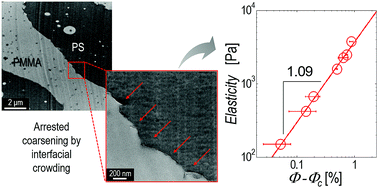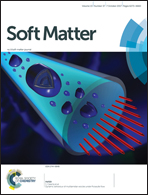Interfacial crowding of nanoplatelets in co-continuous polymer blends: assembly, elasticity and structure of the interfacial nanoparticle network†
Abstract
The sequence of events which leads to the interfacial crowding of plate-like nanoparticles in co-continuous polymer blends is investigated through a combination of morphological and rheological analyses. Very low amounts (∼0.2 vol%) of organo-modified clay are sufficient to suppress phase coarsening in a co-continuous polystyrene/poly(methyl methacrylate) blend, while lower particle loading allows for a tuning of the characteristic size of the polymer phases at the μm-scale. In any case, an interfacial network of nanoparticles eventually forms, which is driven by the preferred polymer–polymer interface. The elastic features and stress-bearing ability of this peculiar nanoparticle assembly are studied in detail by means of a descriptive two-phase viscoelastic model, which allows isolation of the contribution of the filler network. The role of the co-continuous matrix in driving the space arrangement of the nanoparticles is emphasized by means of comparative analysis with systems based on the same polymers and nanoparticles, but in which the matrix is either a pure polymer or a blend with drop-in-matrix morphology. The relaxation dynamics of the interfacial network was found not to depend on the matrix microstructure, which instead substantially affects the assembly of the nanoplatelets. When the host medium is co-continuous, the particles align along the preferred polymer–polymer interface, percolating at a very low amount (∼0.17 vol%) and prevalently interacting edge-to-edge. The stress bearing ability of such a network is much higher than that in the case of matrix based on a homogeneous polymer or a drop-in-matrix blend, but its elasticity shows low sensitivity to the filler content.



 Please wait while we load your content...
Please wait while we load your content...